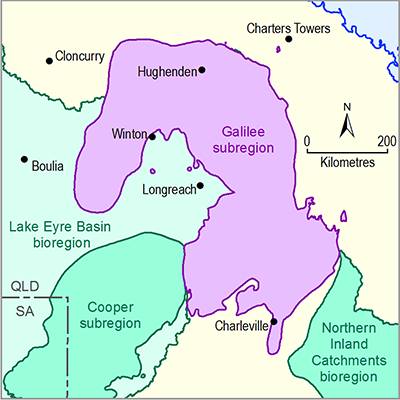The Queensland Government operates a number of stream gauges to monitor water quality under its nine Aquatic Ecosystem Provinces (AEPs) across the state (DERM, 2011b). The Cooper-Bulloo and Diamantina river basins are part of the Lake Eyre AEP, the Flinders river basin is part of the Gulf AEP, the Burdekin and Fitzroy river basins are part of Central AEP and the Warrego river basin is part of the Murray–Darling AEP. The department has about 190 water quality measuring sites including manual and automated sampling. The frequency of sampling varies depending on operational conditions. These measurements generally include electrical conductivity, temperature, pH, turbidity, nutrients, dissolved oxygen and total alkalinity (DERM, 2012).
The availability of water quality data for the Cooper-Bulloo and Diamantina river basins is extremely poor due to logistic and accessibility difficulties associated with monitoring such a vast and sparsely populated area. There are six monitoring sites for water quality data in these basins, of which three are located within the Galilee subregion (Bowen Downs, Longreach and Blackall). Among the sites, continuous auto sensor data are available for Longreach station since 1993 and five or more sampled data are available for Nappa Merrie on Cooper Creek and Autumnvale on the Bulloo River. In addition there are three data logger sites in the Galilee subregion operated by the Lake Eyre Basin Rivers Assessment (LEBRA) program since 2011 (Cockayne et al., 2012). The LEBRA program also operates occasional in situ measurements in its 20 sites all across the LEB. As reported by DERM (2011b), salinity is low and stable at each of the gauging stations but subject to occasional high pulses at some sites. Turbidity is high and subject to varying trends as a result of local influences. It appears turbidity decreases from upstream to downstream and then increases again before the Cooper Creek crosses the Queensland–South Australia border. At Longreach, the median EC is about 200 μS/cm at baseflow and 100 μS/cm at high flows, however occasional high EC values occur anomalously at mid-flow ranges, particularly flows of between 0.1 and 10 m3/s (DERM, 2011b). Data from the LEBRA logger sites also showed a general pattern of increasing salinity throughout the low and no flow periods, followed by sharp lowering during high flow events. At some sites there is a distinct initial rise in salinity when the first flood water arrives (Cockayne et al., 2012).
In the Flinders river basin, there are two stream gauges for water quality measurement, one in the Galilee subregion at Richmond and the other at Walkers Bend on the downstream reach of the Flinders River. Continuous auto sensor data are available for Richmond since 2000 and five or more sampled data are available for Walkers Bend. As reported by DERM (2011b), water quality within the Flinders river basin is reasonably good. Both salinity and turbidity differ between upstream and downstream of the basin. At Richmond EC is quite variable, being around 150 μS/cm at high flows, but commonly ranging up to 450 μS/cm as flow declines during dry conditions. Exceptionally high EC values exceeding 3000 μS/cm occasionally occur at flows of between 0.01 and 0.1 m3/s (DERM, 2011b).
In the Burdekin and Fitzroy basins there are 78 stream gauges for water quality monitoring including one in the Galilee subregion at Violet Grove on Native Companion Creek, many of them have auto sensor records and a large number of sampled data. Overall, salinity is low across the Burdekin and Fitzroy river basins but TN, TP and turbidity concentrations are high at many sites. Rising salinity trends were found in the upper Burdekin and at the end of the system gauging site on the Fitzroy River (DERM, 2011b). Recorded data (2000–2011) at Violet Grove on Native Companion Creek show EC of between 100 and 500 μS/cm, with an mean of 198 μS/cm.
The availability of water quality data in the Warrego river basin is relatively poor. There is only one water quality monitoring site, at Cunnamulla Weir which is located outside the Galilee subregion boundary at about the middle reach of the Warrego River. At Cunnamulla Weir, salinity is high compared to Queensland in general. EC values ranged from as high as 800 μS/cm during baseflow, to 100 to 180 μS/cm at high flows (DERM, 2011b).

